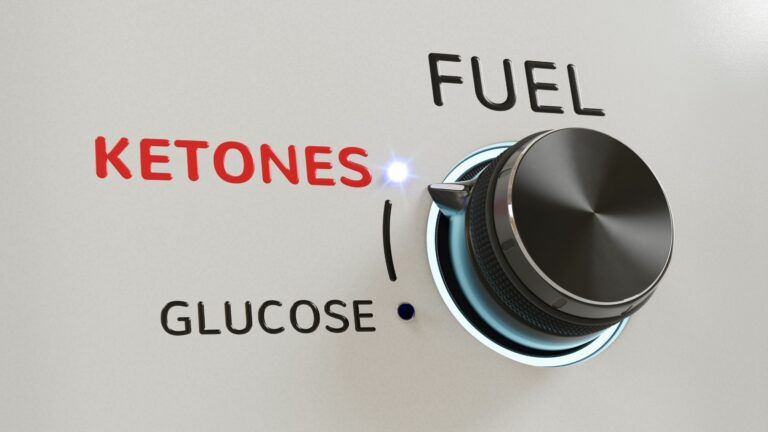Keto Flu Symptoms & Remedies – 6 Ways To Stop The Keto Flu
After a lifetime of fueling our bodies with carbohydrates, it seems reasonable to expect some discomfort when transitioning to fat. During this temporary period of discomfort, termed the “keto flu”, people sometimes experience a variety of symptoms including headaches, body aches, low-energy, stomach upset, and/or an increased need for the bathroom.
Given the current situation, experiencing any flu-like symptoms may raise some concerns. If you are just starting keto it is therefore important to understand the cause of these symptoms and how to eliminate them quickly, or even prevent them all together.
Keto Flu Symptoms
Some people transition into ketosis quite effortlessly and do not experience any noticeable symptoms, while for others the adjustment period can be quite debilitating. It has been speculated that the more reliant you are on carbs prior to starting keto, the more severe your symptoms will be. Other confounding factors include stress, deficiencies in minerals, vitamins, and/or electrolytes, and poor hydration.
While making the switch from burning glucose (sugar) to burning fat you may experience some of the following symptoms:
- Brain Fog
- Carb/Sugar Cravings
- Constipation
- Diarrhea
- Dizziness
- Fatigue/Weakness
- Headaches
- Heart Palpitations
- Irritability
- Muscle Cramps/Soreness
- Nausea
- Stomach Pain
How Long Does the Keto Flu Last?
The keto flu generally sets in between three to seven days after you begin following keto, and it may last anywhere from five days to two weeks. It generally takes 10-21 days for fat adaptation to take hold, but it may take longer if the diet is not maintained consistently.
What Causes the Keto Flu?
Dehydration, mineral and electrolyte deficiencies and toxin release are largely to blame for these symptoms. These issues are not a reflection of any limitations of the keto diet itself, but rather the higher level of support needed to assist the body through the transition into ketosis.
Remember we are reprogramming your body to utilize a completely different fuel source; it will need help making the adjustment.
Glycogen stores a considerable amount of water. When we limit carbs, we use up stored glycogen and in doing so water is released along with minerals and electrolytes. Reducing carbs also lowers insulin levels, which triggers the liver to begin converting fat to ketones for energy instead of glucose.
What does that have to do with it? Well, when your insulin levels drop, your kidneys begin to release more sodium into your urine, along with water. When starting keto, you will likely find yourself needing to urinate more frequently. This is necessary to get rid of the sodium in the kidneys and expel the water that has been stored in the glycogen.
While this transition can bring with it a welcome amount of weight loss during the first couple weeks, the loss of minerals, electrolytes and water also brings along the symptoms of the keto flu. Not to worry however, these symptoms can be alleviated, and once in ketosis, increased energy, mental clarity, and healthy weight loss are quick to follow.
6 Ways To Stop The Keto Flu
The first step to easing the symptoms is to replenish electrolytes. This can be done by consuming real, whole food sources that are high in potassium (fish, clams, meat, leafy greens, avocados and coconut water) and magnesium (leafy greens, raspberries, avocados, broccoli, cabbage, seafood and dark chocolate).
Sodium can be replenished by simply adding Redmond’s Real Sea Salt to foods or consuming a half teaspoon dissolved in a glass of water daily.
In addition to eating healthy nutrient dense foods, here are a few additional tips to help you banish the keto flu even more quickly.
1) Hydrate

Drink plenty of water. A good rule of thumb is to drink half of your body weight in ounces per day. For example, if you weigh 160 pounds, you would drink 80 ounces of water. For every 8 ounces of coffee or other dehydrating beverages you consume, be sure to add an additional 12 ounces of pure water.
Tap water and bottled water should be avoided. These are laden with harsh chemicals that do not contribute as effectively to proper hydration and can disrupt your healthy gut flora. Consider investing in an in-home water filtration system.
Reverse osmosis is good, however the process increases the acidity of the water and removes healthy minerals. My personal preference is a counter top gravity-powered unit called a Berkey Water Filtration System.
2) Consume Bone Broth Regularly
Bone broth contains a considerable amount of sodium, potassium and collagen, and will help you hydrate. You can make it yourself or purchase premade options, but be sure to select broth made from grass-fed or pasture raised sources.
US Wellness Meats, Grassroots Farmers’ Cooperative, and Farm Foods Market offer grass-fed pasture raised bones to make broth with. Brodo and Kettle & Fire (also available on Amazon), are our recommended sources for top quality premade bone broths and soups.
3) Get Adequate Rest

It is important to give your body some time to rest as it transitions into fat-burning mode. Strive for eight hours of sleep per night and ease up on intense exercise for a few days. Walking and yoga are great options to stay active, and they are also great for relieving stress.
Set a consistent time to go to bed each night, and try reading a book prior to bed rather than watching TV or using your computer. Blue light suppresses the release of melatonin in the brain, which can make it difficult to fall asleep. Wearing blue light blocking glasses can also be of benefit if you spend a considerable amount of time on your computer or phone just prior to bedtime.
Avoid eating carbs before bed. A few sticks of celery are a great option to curb hunger. They will not impact insulin or interrupt growth hormone’s fat burning effects. Celery also contains active compounds called pthalides, which relax the muscles of the arteries and also reduce adrenal hormones.
4) Increase Fat Intake
Increasing your fat intake will help reduce cravings and speed up the rate in which your body becomes fat adapted. Consuming an avocado or two per day is a great way expedite the process. They are also easy on the stomach and high in potassium and other nutrients.
Depleting stored glucose through intermittent fasting can also assist the transition into ketosis, and help improve energy and clarity.
5) Try Activated Charcoal or Calcium Bentonite Clay
As you become fat adapted, you will start losing excess body fat quite rapidly. Toxins are stored in fat and are released into the body when fat is burned off. If not properly flushed out of your system, these toxins can tax your liver and kidneys.
Activated charcoal and calcium bentonite clay can help neutralize and bind to toxins, making it easier to transport them out of the body. Bentonite clay also delivers a boost of nutrients including calcium, magnesium, silica, sodium, copper, iron, and potassium.
6) Increase Your Electrolytes
If you are struggling to get electrolytes from whole foods, an electrolyte powder can be beneficial. Adding a little flavor to your water can also make staying hydrated a little easier. Our preferred brand is Dr. Bergs Electrolyte Powder.
One scoop provides 75mg of calcium (from calcium lactate, not carbonate), 120m of magnesium (citrate), 10 mg of chloride (sea salt), and a whopping 1000 mg of potassium (from potassium citrate). It also contains 100mg of a trace mineral complex per serving, and is free of any artificial flavors, colors, sugar or maltodextrin.
How To Avoid The Keto Flu Altogether?
Easing into keto by gradually reducing your carb intake by 10-20 grams per day, and focusing on eating whole, nutrient dense foods can make the transition into ketosis less of a shock to the system. Initiating some of the tips listed above before symptoms occur can also help make the transition much more pleasant.
Did you experience any symptoms when first starting keto? What remedies worked best for you? Please consider sharing your experience by commenting below in order to help others living a fit keto lifestyle.
Thank you for visiting LiveFitKeto.com. Check back often for new content or subscribe to our newsletter to receive updates on new articles, and if you have found this information helpful, please don’t hesitate to share.







